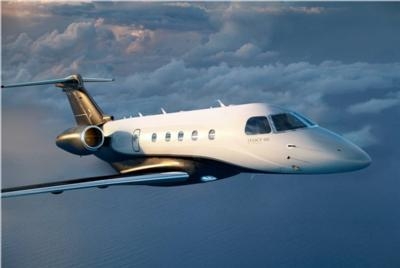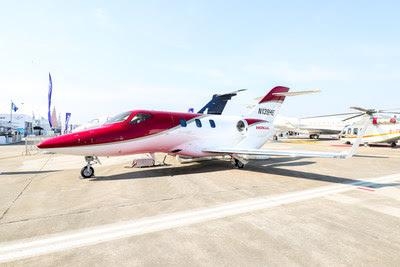Analyst Brian Foley Says It's Possible To Make A Good Guess If You Know Where To Look
Like Apple with its iPhone updates, business jet manufacturers are notoriously tight-lipped about their next new planes, saving the news to make a splash at major aviation conventions and keeping competitors off-balance. Still, through deduction and observation, one can make a good guess as to what their next products could be, according to aviation analyst Brian Foley.

Foley says as an example, it’s logical to think that General Dynamics’ Gulfstream division would be motivated to build a successor to its aging G650ER flagship for two compelling reasons.
First, from an aircraft capability standpoint, Gulfstream hasn’t historically allowed any competitor’s product to have a meaningful edge for long. But Bombardier’s brand new Global 7500 does exactly that, outshining the maximum distance the G650ER flies by 200 miles. Based on previous competitive behavior, Gulfstream normally announces a new or improved model to steal back the range crown. Paradoxically, the Global 7500 already has a whopping 7700 nautical mile range so few would ever benefit from an increase to this practically nonstop-to-anywhere capability. But then sometimes it’s more about branding than a usable improvement in mission capability.
More importantly though, because it’s a generation older, manufacturing techniques for the G650ER are more inefficient and antiquated compared to Gulfstream’s latest G500 and G600 models, which take fewer labor hours and parts to build. By ditching the old G650ER and replacing it with a longer-ranged derivative of the new G600, the company stands to improve margins while optimizing commonality with G500/G600 parts and tooling.

For Embraer, any near-term new product announcement would come as a surprise since it just announced an improvement last year with its Praetor line, a branding and performance update to its previous Legacy 450 and 500. This, coupled with the dust still settling from Embraer’s sale of a majority stake in its commercial airliner division to Boeing, would seemingly keep any business jet announcements at bay for now.
In dodging financial ruin, Bombardier announced its exit from a number of its business lines, but doubled-down in rail transportation and business aviation. This suggests the bizjet announcement pipeline should become more active going forward.
Bombardier differentiates its business jet divisions by cabin size. Think of their small, medium and large jets being branded Learjet, Challenger and Global, respectively. The top-of-the-line Global division has already received a makeover with the Global 5000 and 6000 becoming the 5500 and 6500, and the all-new Global 7500 has just begun deliveries to customers.
Their middle-sized aircraft, the Challenger 350 and Challenger 650, are both overdue for other than incremental improvements. When jet buyers can’t distinguish brand new aircraft from used, there’s less incentive to pay the premium for new. With a heritage going back to the 1970s, the Challenger 650 is arguably most due for a makeover. An even bolder move for Bombardier would be to announce an all-new Challenger replacement, and not just another incremental engine and avionics tweak that would only bore the market and limit sales.
The future of Bombardier’s small-cabin Learjet division is a bit of a question mark, with its last all-new Learjet 85 development project being cancelled and the remaining tired product line delivering just 4 units during the first half of 2019. However, it’s possible that beauty is in the eye of the beholder if taken from HondaJet’s perspective.

Foley says one might reason that HondaJet’s recent 82,000 sq. ft. facility expansion telegraphs a new announcement forthcoming. Currently it’s only a one-trick-pony with its HondaJet light jet. Manufacturers need to have a family of aircraft to have a meaningful market presence and step-up products for their existing customers. When exploring the company’s online job board, the call is out for engineers with expertise in wing, fuselage and systems design; all indicative of an active in-house skunkworks. Thus, either an all-new product or acquisition of an existing program such as Bombardier’s Learjet division are conceivable.
Dassault is still smarting from the cancellation of its brand-new Falcon 5X program due to engine issues. While it subsequently launched the Falcon 6X replacement, the damage has been done in both product flow and market share. It’s a fair bet that any new products will be derived from the 6X wing and fuselage, eventually replacing the older generation Falcon 900 and Falcon 2000 series. As with Gulfstream, having designs based on a modern airframe lowers labor time, parts cost and provides tooling commonality.
Textron Aviation's Cessna has its hands full with three all-new, simultaneous development programs: the recently certified Citation Longitude business jet, SkyCourier package delivery plane and Denali single-engine turboprop. If there were to be pending new announcements it could be enhancements to the decade-old Citation CJ4 and XLS+ – call them the CJ4+ and XLS++.
Most manufacturers have a product path to become more competitive in the marketplace and more efficient on the factory floor. The timing of one or more of these announcements could be as soon as the industry’s NBAA-BACE convention in Las Vegas next month. Until then, builders will characteristically remain tight-lipped, requiring us to deduce what’s next on our own.
(Source: Brian Foley & Associates. Images from file)
 ANN's Daily Aero-Term (04.26.24): DETRESFA (Distress Phrase)
ANN's Daily Aero-Term (04.26.24): DETRESFA (Distress Phrase) ANN's Daily Aero-Linx (04.26.24)
ANN's Daily Aero-Linx (04.26.24) Airborne 04.22.24: Rotor X Worsens, Airport Fees 4 FNB?, USMC Drone Pilot
Airborne 04.22.24: Rotor X Worsens, Airport Fees 4 FNB?, USMC Drone Pilot Airborne 04.24.24: INTEGRAL E, Elixir USA, M700 RVSM
Airborne 04.24.24: INTEGRAL E, Elixir USA, M700 RVSM Airborne-NextGen 04.23.24: UAVOS UVH 170, magni650 Engine, World eVTOL Directory
Airborne-NextGen 04.23.24: UAVOS UVH 170, magni650 Engine, World eVTOL Directory





